Choosing the right Nintendo Switch can be tough. While the Nintendo Switch OLED is the newest and arguably most desirable model, it’s not the only option. If you’re considering buying a Nintendo Switch for the first time, or even upgrading, understanding the differences between the Nintendo Switch OLED, the original Nintendo Switch, and the Nintendo Switch Lite is crucial. Each model offers unique advantages and disadvantages depending on your gaming needs and budget.
The good news is that the core Nintendo Switch experience remains consistent across all three versions. You’ll have access to the same incredible library of games, a similar user interface, and the fundamental handheld versatility that defines the Switch. The main distinctions lie in screen quality, size, TV connectivity, and portability.
This guide will break down the Nintendo Switch OLED vs. Nintendo Switch vs. Nintendo Switch Lite debate, making your decision straightforward and ensuring you choose the perfect console for your gaming lifestyle. Let’s dive into a detailed comparison of these three fantastic Nintendo consoles.
Nintendo Switch Models: Detailed Specs Comparison
To start, let’s look at a side-by-side comparison of the key specifications for each Nintendo Switch model:
| Feature | Nintendo Switch OLED | Nintendo Switch (Original) | Nintendo Switch Lite |
|---|---|---|---|
| Price (USD) | $350 | $300 | $200 |
| Display | 7-inch OLED, 720p, 60Hz | 6.2-inch LCD, 720p, 60Hz | 5.5-inch LCD, 720p, 60Hz |
| Dimensions | 9.5 x 4.0 x 0.55 inches | 9.4 x 4.0 x 0.55 inches | 8.2 x 3.6 x 0.55 inches |
| Weight | 14.9 ounces | 14.1 ounces | 9.8 ounces |
| Battery Life | 4.5 – 9 hours | 4.5 – 9 hours* | 3 – 7 hours |
| Internal Storage | 64 GB | 32 GB | 32 GB |
| TV Docking | Yes | Yes | No |
| Detachable Joy-Cons | Yes | Yes | No |
| Kickstand | Wide, Adjustable | Narrow, Single-Position | None |
| Speakers | Enhanced Audio | Standard Audio | Standard Audio |
| Ethernet Port | Built-in (Dock) | No (Dock) | N/A |
| Color Options | White, Neon Red/Neon Blue | Neon Red/Neon Blue, Gray | Turquoise, Yellow, Gray, Coral, Blue |
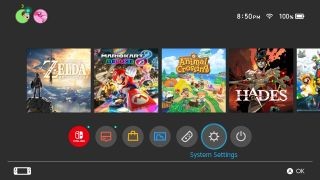
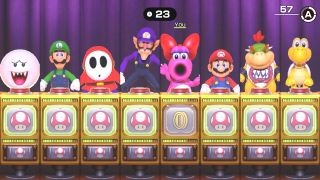
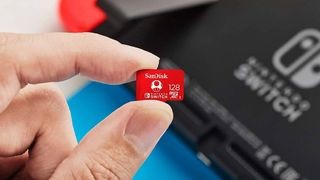
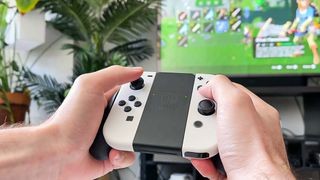
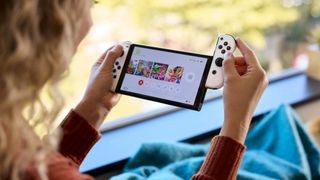

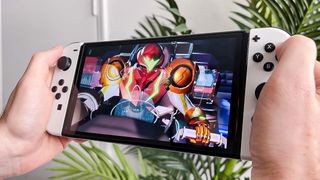
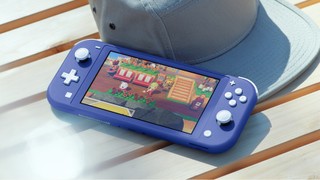
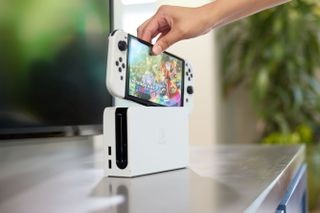
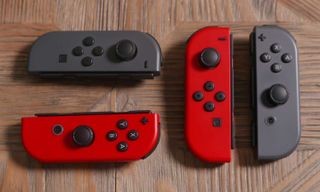
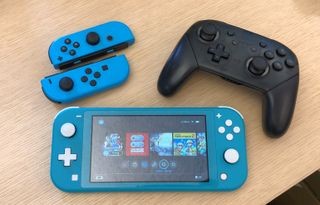
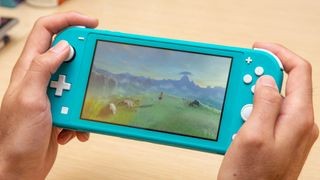
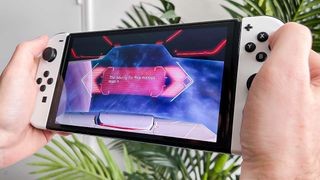
Battery life varies depending on the model year. Later models (2019 onwards) offer the extended battery life of 4.5-9 hours, while earlier models (2018 and before) range from 2.5-6.5 hours.
Similarities Across Nintendo Switch Models
Despite their differences, all Nintendo Switch consoles share core features that define the Nintendo Switch experience. Crucially, they all play nearly the same extensive library of games.
Whether you choose the Switch OLED, standard Switch, or Switch Lite, you’ll have access to blockbuster titles like The Legend of Zelda: Tears of the Kingdom, Animal Crossing: New Horizons, and countless other top-rated Nintendo Switch games. The vast majority of the best Nintendo Switch games are compatible across all models, ensuring a rich and diverse gaming experience regardless of your choice.
(Image credit: Henry T. Casey) All Nintendo Switch models support Bluetooth audio, allowing for wireless headphone use.
The few exceptions are games specifically designed to utilize detachable Joy-Con controllers in ways not possible with the Switch Lite’s integrated controls. Games like 1-2-Switch, Super Mario Party, Ring Fit Adventure, Nintendo Switch Sports, and the Just Dance series are either incompatible or significantly less enjoyable on the Switch Lite due to its lack of detachable controllers and TV output. While technically you could purchase separate Joy-Cons for the Switch Lite, the lack of TV docking makes these party-style games less practical on the smaller, handheld-only screen.
Performance-wise, all Switch models are remarkably similar. They are all powered by a custom Nvidia Tegra processor and 4GB of RAM, ensuring consistent performance across the game library. While the Switch Lite utilizes a Tegra X1+ chip for improved power efficiency and battery life, this doesn’t translate to a noticeable performance boost in games. Storage differences are also minor; the Switch OLED comes with 64GB of internal storage compared to the 32GB in the standard and Lite models. However, all models offer microSD card slots for easy and affordable storage expansion.
(Image credit: Nintendo) Party games like Super Mario Party are less ideal on the Switch Lite due to its handheld-only nature.
Furthermore, every Nintendo Switch model operates in handheld mode, uses the same user-friendly operating system, and supports Wi-Fi, Bluetooth audio, and USB-C accessories. The core software and connectivity features remain consistent, providing a familiar experience across the entire Nintendo Switch family. The standard Switch and Switch OLED share even more similarities, boasting identical dimensions, near-identical weight, comparable battery life, TV connectivity, and detachable Joy-Cons for versatile multiplayer options.
(Image credit: SanDisk) All Nintendo Switch models allow for storage expansion via microSD cards.
Essentially, choosing between Nintendo Switch models won’t drastically limit your gaming library or performance. The key differences lie in design, display, and how you intend to use the console.
Design and Build: Size, Portability, and Features
The Nintendo Switch and Nintendo Switch OLED share a similar design philosophy – a central tablet-like console with detachable Joy-Con controllers. They are virtually the same size and weight, making the transition between these models seamless in terms of handling.
(Image credit: Tom’s Guide) The Nintendo Switch OLED and standard Switch both feature detachable Joy-Con controllers and TV docking capabilities.
Key design differentiators between the standard Switch and OLED model include enhanced speakers on the OLED for richer audio and a significantly improved kickstand. The Switch OLED features a wide, sturdy kickstand that spans the console’s rear and offers adjustable viewing angles, a major upgrade over the standard Switch’s thin, single-position kickstand. This makes tabletop mode gaming much more enjoyable on the OLED model.
(Image credit: Nintendo) Detachable Joy-Cons offer versatile control options on both the standard Switch and Switch OLED.
The Nintendo Switch Lite, however, represents a distinct design departure. It’s significantly smaller and lighter, designed purely for handheld gaming. It lacks TV docking capabilities and features integrated controls, meaning the Joy-Cons are not detachable. This compact design makes the Switch Lite the most portable of the three, ideal for gaming on the go. A notable design advantage of the Switch Lite is the inclusion of a dedicated D-pad, which many gamers prefer over the standard Switch’s directional buttons, particularly for 2D games.
(Image credit: Tom’s Guide) The Nintendo Switch Lite is designed for handheld-only gaming and is the most portable model.
Display Differences: LCD vs. OLED
The most immediately noticeable difference between the Switch models is their displays. The Nintendo Switch Lite has the smallest screen at 5.5 inches, followed by the standard Switch at 6.2 inches. Both utilize LCD technology, offering decent brightness and color reproduction for their class.
However, the Nintendo Switch OLED boasts a superior 7-inch OLED display. OLED technology provides significantly enhanced contrast, deeper blacks, and more vibrant colors compared to LCD screens. This results in a richer, more immersive visual experience, making games look more dynamic and engaging, especially those with vibrant color palettes or dark environments. While all three screens share the same 720p resolution and 60Hz refresh rate, the OLED panel on the Switch OLED offers a clear visual upgrade.
(Image credit: Tom’s Guide) The Nintendo Switch OLED’s display offers superior contrast and color vibrancy compared to the LCD screens of the other models.
Docking and TV Compatibility: Handheld vs. Hybrid
A fundamental distinction is TV docking capability. The Nintendo Switch and Nintendo Switch OLED are hybrid consoles, designed to be played both in handheld mode and on a TV. They include a dock that connects to your TV, allowing you to switch seamlessly between portable and big-screen gaming.
The Nintendo Switch Lite, in contrast, is purely a handheld console. It cannot be docked or connected to a TV. This makes it less versatile but caters to gamers who primarily play in handheld mode or value portability above all else. For families with limited TV access or gamers who primarily game on the go, the Switch Lite can be a compelling option.
(Image credit: Nintendo) The Nintendo Switch Lite is solely a handheld gaming console and cannot be docked to a TV.
The docks themselves also have a minor difference. The Nintendo Switch OLED dock includes a built-in Ethernet port for a wired internet connection, while the standard Switch dock does not. For gamers who prioritize a stable online connection for docked play, the OLED dock offers a slight advantage.
(Image credit: Nintendo) The Nintendo Switch OLED dock includes a built-in Ethernet port for wired internet connectivity.
Controllers: Joy-Cons and Control Options
The Nintendo Switch and Nintendo Switch OLED utilize detachable Joy-Con controllers, offering a range of control options. Joy-Cons can be used attached to the console in handheld mode, detached for individual player use in multiplayer, or combined into a traditional gamepad using a grip. This versatility is a hallmark of the Nintendo Switch experience, enabling spontaneous multiplayer gaming and various play styles.
(Image credit: Tom’s Guide) Detachable Joy-Cons provide flexible control options for the Nintendo Switch and Switch OLED.
The Nintendo Switch Lite features integrated controls; the controllers are built directly into the console and are not detachable. While you can pair external controllers like Joy-Cons or the Nintendo Switch Pro Controller with the Switch Lite, its lack of a kickstand makes using external controllers less convenient in handheld mode without a separate stand accessory.
(Image credit: Tom’s Guide) While external controllers can be paired, the Switch Lite’s design is primarily optimized for integrated handheld controls.
Battery Life and Portability
Battery life varies across the models. The Nintendo Switch Lite, despite its smaller size, offers a battery life of approximately 3 to 7 hours, depending on the game. The Nintendo Switch and Nintendo Switch OLED are advertised to offer a similar range of 4.5 to 9 hours. However, older models of the original Nintendo Switch (pre-2019) have shorter battery life. Newer standard Switch models match the OLED in battery performance, and in some tests, the Switch OLED slightly outperforms the standard Switch in battery longevity due to the OLED screen’s power efficiency.
(Image credit: Future) The Nintendo Switch Lite offers a respectable battery life for handheld gaming.
For maximum portability, the Switch Lite is the clear winner due to its smaller size and lighter weight. It’s the most travel-friendly option for gamers who prioritize on-the-go play.
(Image credit: Tom’s Guide) The Nintendo Switch OLED offers comparable battery life to the standard Switch, with potentially slight improvements.
Price and Value Proposition
Price is a significant factor in choosing a Nintendo Switch model. The Nintendo Switch Lite is the most affordable at $200, making it an attractive entry point to the Nintendo Switch ecosystem or a budget-friendly option for dedicated handheld gamers. The standard Nintendo Switch is priced at $300, offering the hybrid experience at a mid-range price. The Nintendo Switch OLED is the premium option at $350, justifying its higher price with the superior OLED screen, enhanced audio, and improved build quality.
The value proposition of each model depends on individual needs. The Switch Lite offers excellent handheld gaming at the lowest cost. The standard Switch provides a versatile hybrid experience at a reasonable price. The Switch OLED delivers the most premium visual and audio experience for those willing to invest more. Bundles, like the Mario Kart 8 Deluxe bundle often available with the standard Switch, can further enhance the value of specific models.
Recommendations: Which Nintendo Switch Should You Buy?
Nintendo Switch OLED: The best overall experience. If budget is less of a concern, the OLED model offers the most refined and immersive Nintendo Switch experience. Ideal for new buyers and those looking for the best visuals and tabletop gaming.
Nintendo Switch (Standard): The balanced choice. A great all-rounder, offering the hybrid experience at a mid-range price. Suitable for those who want TV docking and Joy-Con versatility without the premium price of the OLED. Consider bundles for enhanced value.
Nintendo Switch Lite: The portable and budget-friendly option. Best for dedicated handheld gamers or those on a tighter budget. Ideal for commuting, travel, and younger players who primarily game in handheld mode.
Ultimately, the “best” Nintendo Switch depends on your personal preferences and gaming habits. Consider how you intend to play, your budget, and which features are most important to you.
Buy Now or Wait for a New Nintendo Switch?
The Nintendo Switch family is well-established, and rumors of a “Nintendo Switch Pro” or “Nintendo Switch 2” circulate periodically. However, Nintendo has indicated continued support for the current Switch lineup. With a vast library of games and more on the horizon, the current Nintendo Switch models offer a mature and compelling gaming platform.
If you’re eager to play Nintendo Switch games now, there’s no need to wait. The current models provide excellent gaming experiences, and the Switch library is rich and diverse. While future consoles are inevitable, the existing Nintendo Switch models offer fantastic value and entertainment today.
Conclusion: Choose the Nintendo Switch That Fits Your Style
Choosing between Nintendo Switch models comes down to prioritizing your gaming needs and budget. Whether you value the premium display of the OLED, the versatility of the standard Switch, or the portability of the Lite, there’s a Nintendo Switch to suit your style. By understanding the key differences and similarities, you can make an informed decision and dive into the world of Nintendo Switch gaming with the perfect console for you.
